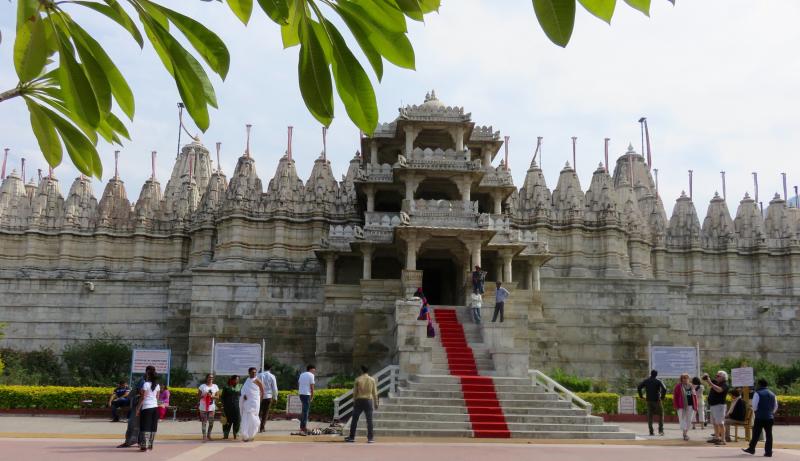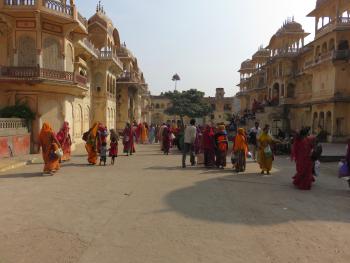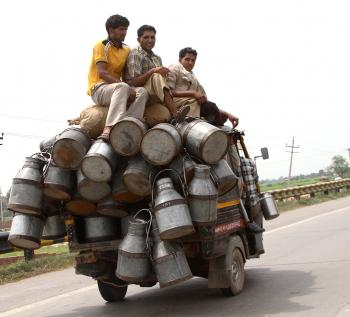Incredible India — a feast for the senses
This article appears on page 22 of the September 2016 issue.
Fellow pilot Zaman Khan said, “India… all good memories and smells, but India is not for sissies.”
This statement would prove to be profound, as it surfaced, front and center, during our Nov. 13-Dec. 2, 2015. trip to a land advertised by their department of tourism as “Incredible India.” My wife, Rita, and I found a complex land of amazing diversity, one which certainly begs for a return visit.
Getting there
We were told, in three separate conversations, by well-respected travelers, “If you are going to go that far away, do yourself a gigantic favor: do it first class. Fly there first class. Stay there first class… in the best hotels your money can buy. And travel — just the two of you — in a sizeable air-conditioned car with an extremely competent driver and an educated guide. No tour buses.”
“Also, watch what you eat.”
We did exactly that. We dug deeper into our budget-travel pockets than we ever had before for this special journey, and it was first class the whole way.
We paid $5,530 per person, inclusive of all internal flights, 5-star accommodations with daily breakfast and dinner and touring with a private car and guide, all arranged with Services International, based in New Delhi (india-travel.com).
It was so exciting getting off the plane at Delhi’s Indira Gandhi International Airport. (Well, just ungluing ourselves from our seats — even first-class seats — after 19 hours helped!) However, long before we landed, our anticipation of this adventure had been building. This was a carefully thought-out journey that we had been preparing for over many months.
An invigorating introduction
We planned to travel the loop known as the Indian Golden Triangle, taking us from Delhi to Agra and the state of Rajasthan, with a few extra gems tossed in, including the Holy City of Varanasi and the Sikh stronghold of Amritsar near the Pakistan border.
We had arranged for three days of recuperating from our across-the-world flight, touring in the companionship of some Delhi friends.
I would shortly discover that India is magic. The entire country should not work at all, but somehow it does, if ever so differently.
Our first experience, a fantastic one, was a ride through a working-class neighborhood near the Jama Masjid (mosque) on a man-powered tricycle rickshaw. Our driver seemed to effortlessly pedal us through a churning mass of society — so fascinating.
On to Amritsar
The next step of our journey began with a flight to Amritsar, in the northwestern state of Punjab, for the colorful border-closing ceremony at Wagah along the Grand Trunk Road. This road, which passes from Amritsar, India, to Lahore, Pakistan, is the only open highway that links these two not-so-neighborly countries.
With prodigious self-confidence, each country’s soldiers fluently mustered up their jingoism in a military display of great pomp. The high-stepping, mustached warriors on both flanks conducted the evening flag-lowering ceremony with demanding accuracy throughout the blustery ritual.
I had touted this ceremony to be one of the highlights of our trip. I first saw it on YouTube and was struck by its colorful pageantry and precise ceremony.
Alas, as great expectations seem to go, the YouTube version was better than real life, as the videographer had received a prime spot in front of the procession.
However, it was still a grand experience — the bugling, the barking of orders and the colorful dress all were quite vivid.
After the show, hawkers besieged us. They were selling postcards, videos, soft drinks, picture books, flags and other paraphernalia that befitted such a ceremony plus so much more. This colossal mass of humanity — an inescapable occurrence on the Indian subcontinent — would remain an extreme constant during our travels in this extraordinary land.
Evening aromas in Amritsar wafted past us from the cooking fires of street vendors, some tucked into sparsely lit alleyways.
The striking intoxication of spices is as exceptional there as any place on Earth. Their use of cumin, turmeric, mustard seeds, cardamom, cinnamon, coriander and chili peppers (just to name a few) brought tears to our eyes… sometimes in more ways than one.
A sweet, light curried corn-and-crab soup accompanied our dinner that night.
A massive meal
A hectic drive the next day through the city of Amritsar took us to within 10 blocks of the Golden Temple complex. The final stretch through the Old City was by trishaw, and the cacophony of bike bells “cha-chinging” was melodious.
The Golden Temple, glistening upon its surrounding lake, houses the Sikh holy book “Guru Granth Sahib” and is touted as one of the most tangibly spiritual places in all of India.
The marble temple is plated with gold, and designs of precious stone encrust the structure. A triple wow!
Within the temple complex is a dining hall that serves what is known as the largest free lunch in the world. The meal is served to anyone who attends. It is caste free and allows no separation between the wealthy and poor.
The temple has served up to 100,000 meals in a single day, exemplifying the Sikh doctrine of equality for all mankind.
Venturing to Varanasi
After several flight connections, we arrived in the holy city of Varanasi, located in northern India. It is India’s oldest city, situated on the bank of the sacred Ganges River, a site for the spiritual cleansing of the Hindu body, mind and soul.
When our minivan could not travel any farther, as the streets narrowed into alleyways, we began afoot in the dark of early morning on a journey like none other we’d ever taken in our lives. This was, for me, a thought-provoking journey.
The streets were filled with worshipers crowding toward the water’s edge. In the mix were touts of everything and anything. Flower dealers, postcard vendors, photographers, trinket salesmen and food carts were spread about, disrupting the movement of the mostly human traffic.
Loudspeakers blared devotional chants along with the ever-present horn blowing and “cha-chinging” of trishaws and bicycle bells.
Sacred cows milled about most everywhere, and there was utterly no direction to anything, no such entity as order.
Into the chaos
Children tugged unashamedly for baksheesh, charitable handouts for doing nothing. These little alms-takers were relentless — with mothers not far behind, watching and then taking control of the booty.
The waste of unwanted everything was scattered into the corners of the streets, occasionally swept away but only as far as the next heap. (Oddly, there was no foul stench.)
Into this chaos and din of mankind, we steadily moved onward toward the ghats, the uneven steps that led down to the Ganges. As we approached the river, the chanting of the Vedic mantras (sacred utterances) increased their hypnotic intonations.
The crowd pressed against us. It was tight — nearly claustrophobic — and filled with incredible pandemonium. I had a feeling of wanting to escape, but once we boarded our oared boat and moved away from the ghat, the city noises softened somewhat and we became giftedly unattached from the masses. It was a knockout to all of my senses to experience quietness once again.
As the sun appeared, we had a misty, maybe smog-filled, view of Varanasi, a sight enduringly entrenched in each of our minds.
A note on air quality in India — it is quite horrible, indeed. The charts that list the cities of the world and their air quality give cities like Delhi miserable ratings. The air quality is listed as hazardous, and before you go should be the time to think about how long you wish to breathe it.
Getting into the groove
Our residence for several nights in Varanasi was Nadesar Palace, a Taj hotel boasting 10 extremely well-appointed guest rooms. The grounds and buildings were well manicured and worthy of this estate of historic background, known in India as a haveli.
We were welcomed with a garland of flowers, and a horse and carriage drove us throughout the grounds. The air inside and out was quite British.
A drum and sitar accompanied al fresco dinners; a flute accompanied our morning’s fare.
As our days wandered into our first week, an order began to appear. The bedlam started to morph into a more recognizable rhythm.
These devoutly religious people intertwine their faith into everyday activities, with “Namaste,” uttered with a slight bow and the clasp of hands close to one’s chest, as in prayer, encountered everywhere.
Translated from Hindi as “I bow to the divine in you,” it shows honor, courtesy, politeness and hospitality from one soul to another. It seemed that there was time for peacefulness in each Indian’s day.
Rajasthan and beyond
We drove from Delhi to Agra with our trustworthy driver and guide, Thakur. Once in Agra, we, of course, went to the must-see Taj Mahal, on which construction began in 1632.
Then we returned to western India for a thorough exploration of the state of Rajasthan, which incorporates a large portion of the Thar Desert, making it a mostly dry and sandy state.
We visited the deserted city of Fatehpur Sikri, built in 1569 by the Mughal emperor Akbar as his new capital city. But after little more than 10 years, the city was deserted because of its lack of water.
Though uninhabited for more than 400 years, it is still in amazingly stellar condition (and is a UNESCO World Heritage Site).
Our next stop was Pushkar, and we arrived on the last day of its yearly camel festival.
The fair was fantastic, as most outdoor animal festivals are. It was an extremely colorful event and one that we both would certainly return to see again.
The camels were decorated in high fashion, and the populace attending the event was colorful and engaging to watch. This was akin to a country carnival, complete with two Ferris wheels.
Lakeside luxury
Thakur picked us up for the 6-hour drive to Udaipur, where we were scheduled to stay at the Taj Lake Palace. This maharaja’s palace, built in the mid-1700s, has been converted into a magnificent hotel with 80-plus suites. Approximately four acres in size, the property is located on Lake Pichola.
We boarded the hotel’s sun-shaded power launch in front of the handsome, land-side City Palace. After a 10-minute ride we arrived at the hotel dock, where it was explained to us that the Taj Lake Palace has been designated as the most romantic lodging in all of India. When we disembarked, we were ushered ashore by a uniformed escort with a large, tasseled umbrella. Rose petals fell in our path. It was an absolutely fine beginning.
We enjoyed evenings of music and Indian dance performances, and dinners were served with lovely lake vistas. It was incredibly lavish by any standard.
After several days in this exceptional city, exploring the massive City Palace, boating around the lake, visiting other lavish islands and doing a bit of souvenir shopping, we motored on to nearby Ranakpur, an hour-and-a-half drive on mostly country lanes. Troops of monkeys lined the road, standing as sentinels for our midday arrival.
Beautiful buildings
The temple in Ranakpur, our next stop, was sheer magic! Followers of the Jain religion began building this masterpiece in the mid-1400s.
Constructed of lightly shaded marble, the structure is supported by internal pillars, all 1,444 of which are carved with exquisite detail, with no two alike.
An audio guide led us from one station to the next, providing information about the historical significance of the temple and its architectural achievements.
Soon we were headed north again, this time on our way to Jodhpur with the promise of a lodging that could not be outclassed by any hotel in the world.
The Umaid Bhawan Palace is, without a doubt, the single finest residence in which Rita and I have ever been guests. This was luxury beyond what I ever could imagine, but I soon felt quite at home within the bounds of this lavishness, having been so recently coddled in Udaipur.
A journey’s end
The final city on our itinerary was Jaisalmer, farther west about five to six hours by car, depending on traffic.
We stayed two nights in Jaisalmer, a western outpost with, arguably, the most interesting of all of India’s forts. There, the city folks actually live their day-to-day lives within the fortress’ walls. Unfortunately, there were no known suitable hotels within the city’s walls, so we stayed at an older palace within eyesight of the western fort wall.
On our final day, we headed further into the sand dunes by camel. This was our last treat before our journey’s end. And a real treat it was — a soothing sway, side to side, on a plodding, saddled camel.
We started our final day in Jaisalmer with a 4 a.m. wake-up call. At 5:45, Thakur, Rita and I began our 5-plus-hour drive to Jodhpur’s airport to catch a connecting flight to Delhi.
A schedule change delayed us two hours, finally putting us in Delhi with an 8-hour layover before our 12:45 a.m. departure on Air Canada. A mere 15 hours later we were in Toronto clearing Customs, then winding our way to our flight to Miami.
Three-and-a-half hours after that, we headed home by taxi, arriving at our doorstep at noon.
That, my friends, is about 40 hours of travel. First class ($3,200 per person, round trip) was very well worth it!
We were probably overly ambitious in planning this journey, fitting in perhaps too many sites, but, in weary hindsight, we are happy to have seen them all. F



